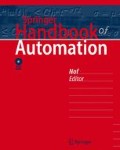Abstract
Automation is a way for humans to extend the capability of their tools and machines. Self-operation by tools and machines requires four functions: Performance detection; process correction; adjustments due to disturbances; enabling the previous three functions without human intervention. Development of these functions evolved in history, and automation is the capability of causing machines to carry out a specific operation on command from external source. In chemical manufacturing and petroleum industries prior to 1940, most processing was in batch environment. The increasing demand for chemical and petroleum products by World War II and thereafter required different manufacturing setup, leading to continuous processing and efficiencies were achieved by automatic control and automation of process, flow and transfer. The increasing complexity of the control system for large plants necessitated applications of computers, which were introduced to the chemical industry in the 1960s. Automation has substituted computer-based control systems for most, if not all, control systems previously based on human-aided mechanical or pneumatic systems to the point that chemical and petroleum plant systems are now fully automatic to a very high degree. In addition, automation has replaced human effort, eliminates significant labor costs, and prevents accidents and injuries that might occur. The Purdue enterprise reference architecture (PERA) for hierarchical control structure, the hierarchy of personnel tasks, and plant operational management structure, as developed for large industrial plants, and a frameworks for automation studies are also illustrated.
Access this chapter
Tax calculation will be finalised at checkout
Purchases are for personal use only
Abbreviations
- PERA:
-
Purdue enterprise reference architecture
References
T.J. Williams: The Purdue Enterprise Reference Architecture (Instrument Society of America, Pittsburgh 1992)
H. Li, T.J. Williams: Interface design for the Purdue Enterprise Reference Architecture (PERA) and methodology in e-Work, Prod. Plan. Control 14(8), 704–719 (2003)
G.A. Rathwell, T.J. Williams: Use of Purdue Reference Architecture and Methodology in Industry (the Fluor Daniel Example). In: Modeling and Methodologies for Enterprise Integration, ed. by P. Bernus, L. Nemes (Chapman Hall, London 1996)
T.J. Williams, P. Bernus, J. Brosvic, D. Chen, G. Doumeingts, L. Nemes, J.L. Nevins, B. Vallespir, J. Vliestra, D. Zoetekouw: Architectures for integrating manufacturing activities and enterprises, Control Eng. Pract. 2(6), 939–960 (1994)
T.J. Williams: One view of the future of industrial control, Eng. Pract. 1(3), 423–433 (1993)
T.J. Williams: A reference model for computer integrated manufacturing (CIM). In: Int. Purdue Workshop Industrial Computer Systems (Instrument Society of America, Pittsburgh 1989)
T.J. Williams: The Use of Digital Computers in Process Control (Instrument Society of America, Pittsburgh 1984) p. 384
T.J. Williams: 20 years of computer control, Can. Control. Instrum. 16(12), 25 (1977)
T.J. Williams: Two decades of change: a review of the 20-year history of computer control, Can. Control. Instrum. 16(9), 35–37 (1977)
T.J. Williams: Trends in the development of process control computer systems, J. Qual. Technol. 8(2), 63–73 (1976)
T.J. Williams: Applied digital control – some comments on history, present status and foreseen trends for the future, Adv. Instrum., Proc. 25th Annual ISA Conf. (1970) p. 1
T.J. Williams: Computers and process control, Ind. Eng. Chem. 62(2), 28–40 (1970)
T.J. Williams: The coming years... The era of computing control, Instrum. Technol. 17(1), 57–63 (1970)
Author information
Authors and Affiliations
Corresponding author
Editor information
Editors and Affiliations
Rights and permissions
Copyright information
© 2009 Springer-Verlag Berlin Heidelberg
About this chapter
Cite this chapter
Williams, T.J. (2009). Advances in Industrial Automation: Historical Perspectives. In: Nof, S. (eds) Springer Handbook of Automation. Springer Handbooks. Springer, Berlin, Heidelberg. https://doi.org/10.1007/978-3-540-78831-7_2
Download citation
DOI: https://doi.org/10.1007/978-3-540-78831-7_2
Publisher Name: Springer, Berlin, Heidelberg
Print ISBN: 978-3-540-78830-0
Online ISBN: 978-3-540-78831-7
eBook Packages: EngineeringEngineering (R0)

